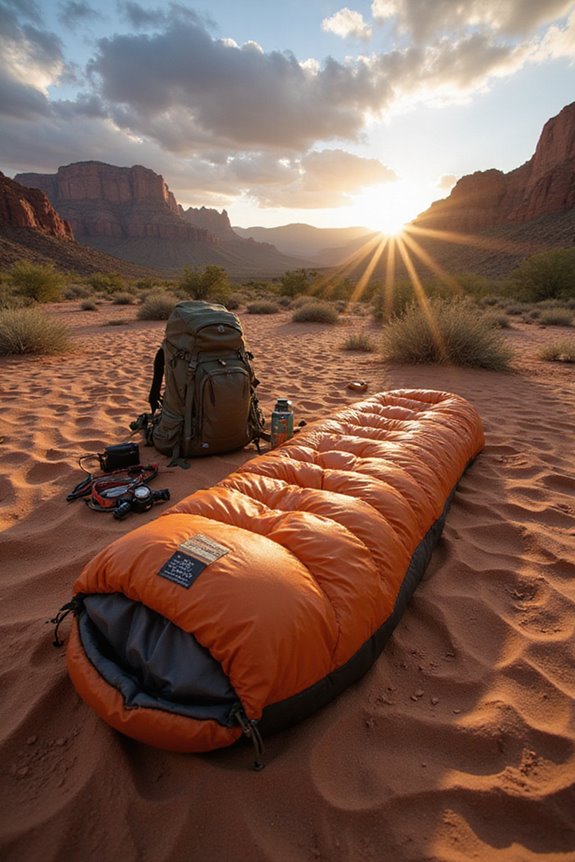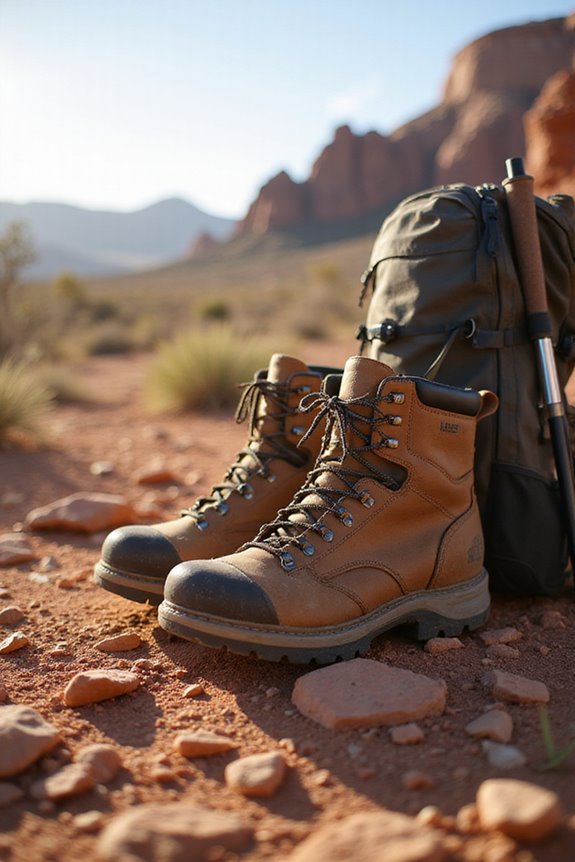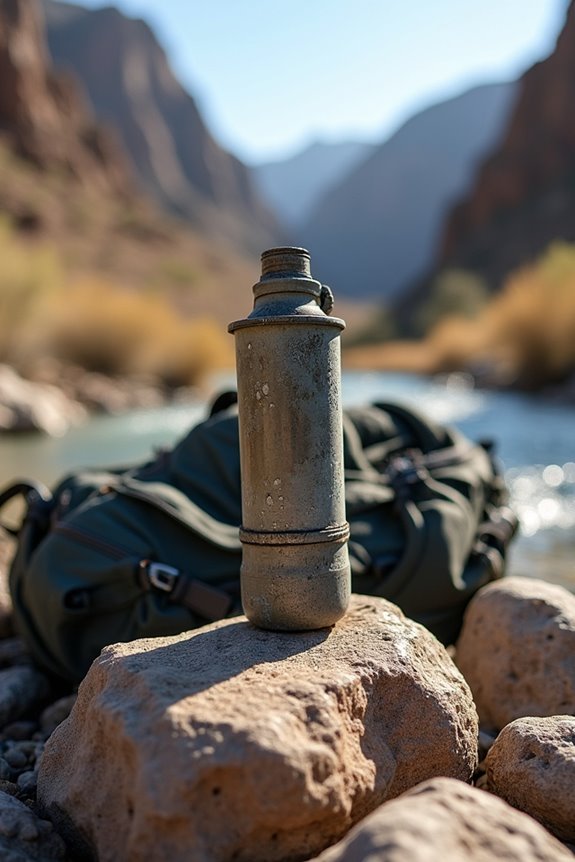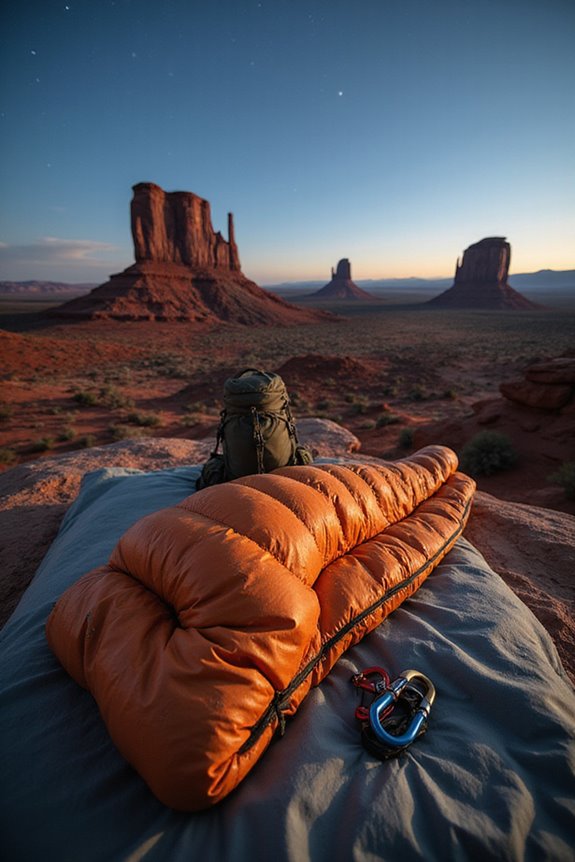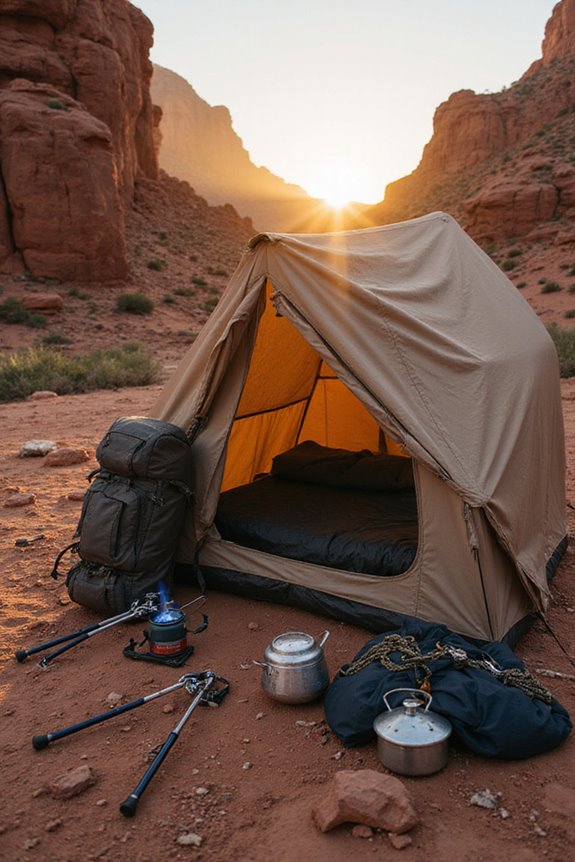Choosing the perfect sleeping bag can redefine our camping experience! Let’s start with the type—mummy bags are great for keeping cozy in the cold, while rectangular bags offer space to sprawl. Insulation matters too! Down is light but fussy about moisture, while synthetic is your reliable wet weather buddy. Don’t forget about fit and temperature ratings; grab a bag rated lower than expected temps for snuggly dreams! Want to discover the best options for every adventure? Stick with us!
Key Takeaways
- Determine the type of sleeping bag based on your needs, such as rectangular for comfort or mummy for warmth.
- Choose an insulation material that suits your conditions: down for lightweight warmth, synthetic for wet weather, or hybrid for versatility.
- Check the temperature rating, ensuring you select a bag rated at least 20°F lower than expected nighttime temperatures for optimal comfort.
- Consider size and fit, opting for longer or width variations to avoid restrictions and enhance comfort during sleep.
- Look for additional features like draft collars, hood cinches, and internal pockets to improve warmth and convenience while using the bag.
Understanding Different Types of Sleeping Bags
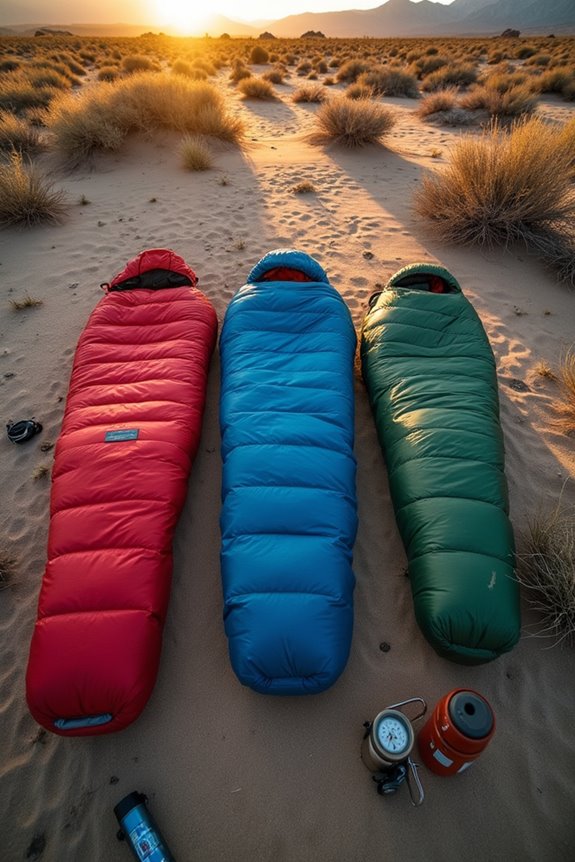
When it comes to choosing the right sleeping bag, we all know how overwhelming it can get—especially with so many options out there! Let’s explore the vibrant world of sleeping bag shapes and designs. For those who love to stretch out, rectangular bags are a dreamy choice, doubling as comforters in warmer weather. If we’re venturing into the great outdoors on chilly nights, mummy bags offer a snug trap for heat, perfect for backpacking adventures. For families or couples, double sleeping bags create a shared cozy haven. Consider options with temperature ratings between 28F to 59F for optimal comfort in various conditions. And we can’t forget about the little explorers! Kids’ bags are fun-sized, ensuring everyone has a great night’s sleep. So grab one that suits your style, and let’s hit the trails!
Evaluating Insulation Materials
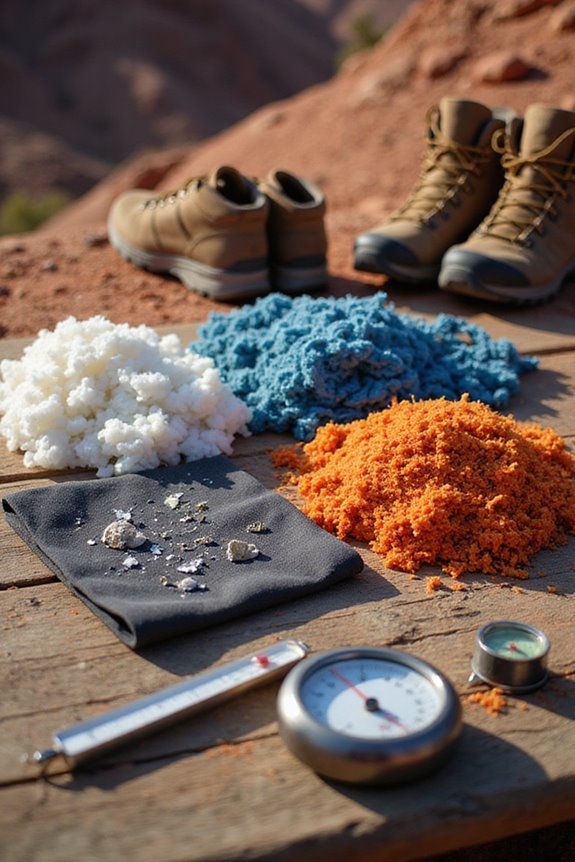
After exploring the wonderful variety of sleeping bag shapes, let’s tackle what really keeps us cozy on those chilly nights: insulation materials! We’ve got down, synthetic, and hybrid options to evaluate. Down is light and warm, but it panics in moisture; it’s like a diva that needs special care! On the flip side, synthetic insulation laughs at wet conditions, holding strong and drying fast. Plus, hybrid materials marry the best of both worlds, keeping us toasty while resisting moisture—a true team player!
Choosing the right insulation types can make or break our adventures. When selecting down insulation specifically, look for options with higher fill power (600-800) for superior insulation quality and an excellent warmth-to-weight ratio in extreme conditions. So, let’s embrace these materials, weigh our options, and get ready for those starry nights under the open sky—freedom awaits!
Decoding Temperature Ratings
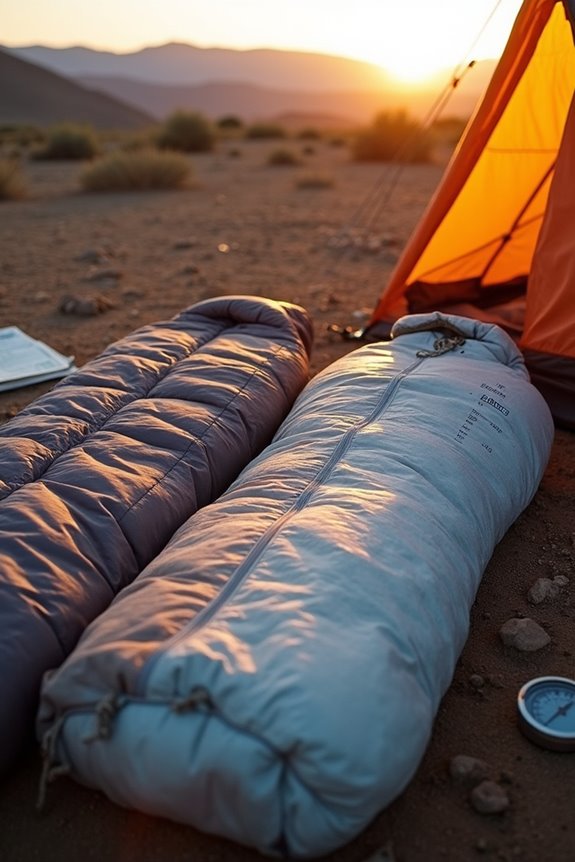
How can we truly gauge if our sleeping bag will keep us snug under a blanket of stars? Let’s explore temperature ratings! With the EN and ISO systems, we can understand the temperature nuances of our bags. Comfort ratings cater to our cozy female friends, while Lower Limit ratings set the scene for the guys. Remember, these aren’t guarantees. They’re based on lab tests, but environment and personal factors definitely come into play. For us adventurous souls, choosing a bag rated a tad lower than expected temperatures is wise. Coupling our bag with a solid sleeping pad boosts warmth, too! For optimal comfort in unpredictable conditions, aim for a comfort rating at least 20°F lower than your expected nighttime temperatures. So, let’s gear up properly and chase those starry nights without a chill!
Size and Fit Considerations
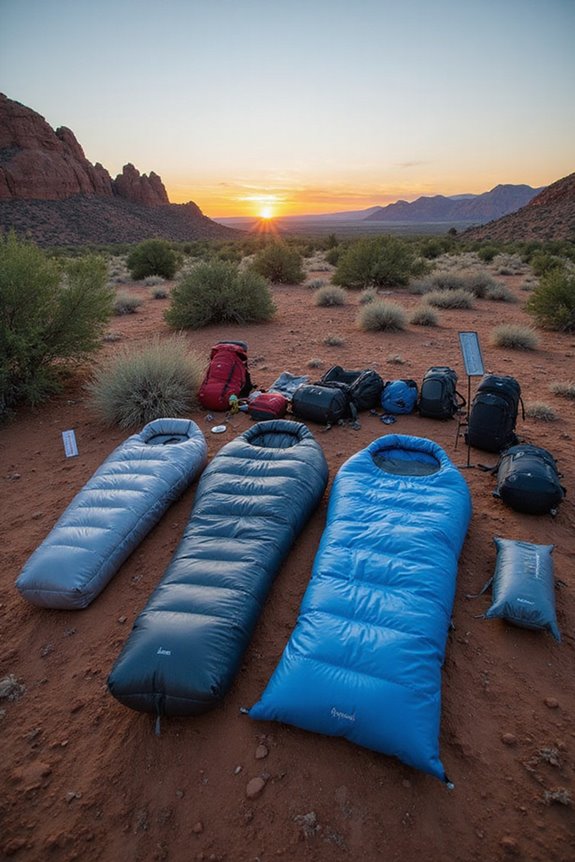
Choosing the right sleeping bag size is essential if we want cozy nights under the stars! We’ve all been there—trying to slide into a bag that’s either too tight or too loose. For the perfect fit, let’s consider those length variations! A longer bag gives us room to stretch out while avoiding the dreaded cold spots. Plus, we can adjust the fit with hoods and collars for that snug warmth around our heads.
Let’s not forget the width! Some of us may prefer the extra space for mobility, especially if we’re side sleepers. Consider that envelope style bags offer more room for movement but may sacrifice some heat retention compared to mummy designs. By taking our height and girth into account, we’ll find our ideal bag and be ready for those epic nights outdoors without feeling like we’re in a sleeping bag straight jacket!
Assessing Weight and Packability
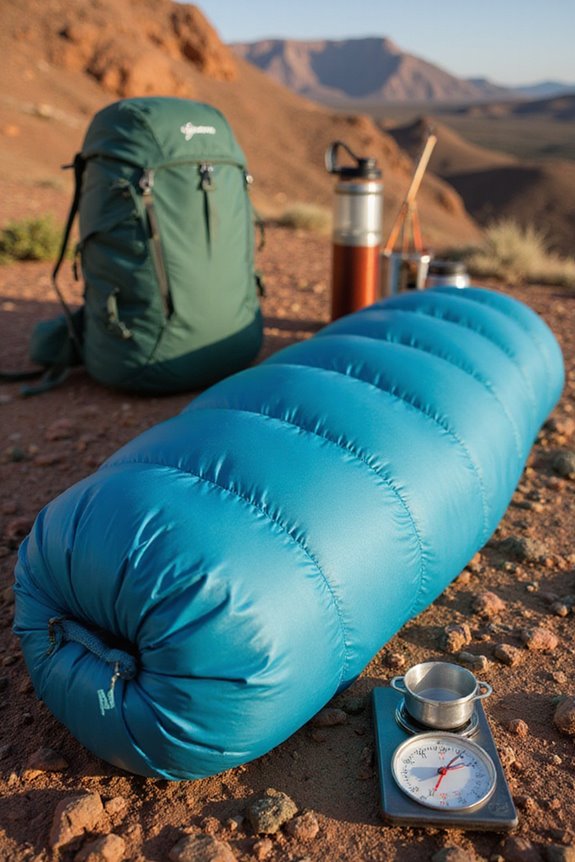
When it comes to evaluating weight and packability in sleeping bags, a little knowledge can go a long way! We all crave the thrill of the trail without being bogged down by excess weight. Ultralight mummy bags, often tipping the scales under 2 pounds, are a gift for fastpackers like us. However, remember that weight distribution plays a vital role. While down bags are marvels of compressibility and warmth-to-weight ratio, heavier rectangular ones can give us more room but at the cost of space in our packs. Don’t forget compression techniques—using quality compression sacks can condense our gear considerably! For optimal backpacking, look for sleeping bags in the 1.5 to 4.4 pounds weight range that compress down to 7.9-14.2 inches. So, let’s strike that perfect balance, ensuring our adventures are both liberating and enjoyable! Happy trails!
Additional Features to Enhance Comfort
While we often focus on the essentials like insulation and weight, it’s the additional features that really elevate our sleeping bag experience! Comfort features like draft collars and hood cinches keep our warmth snug, stopping chilly winds from cramping our style. And let’s not forget those internal stash pockets—perfect for keeping our headlamps and snacks close at hand.
Usability enhancements, such as two-way zippers and compression stuff sacks, make our outdoor adventures a breeze. Whether we’re cozying up under the stars or unzipping on a hot night, these thoughtful additions transform a simple bag into a home away from home. So, let’s gear up right—because comfort is key when we’re chasing the freedom of the wild!
Ideal Applications for Various Sleeping Bags
Finding the perfect sleeping bag for your adventures is essential, especially when we consider the diverse environments we might encounter. For warm-weather camping, those roomy rectangular bags let you stretch out and keep cool. If we’re backpacking or bikepacking, we’ll want a lightweight, compact option that doesn’t weigh us down, especially when we’re racing against the sun.
For frigid temps, mummy bags are our best bet, offering unbeatable insulation to keep us cozy in the cold. Each bag suits specific sports and temperature conditions, so picking the right one makes all the difference. Ultimately, let’s prioritize comfort and function, ensuring we can focus on the joy of exploring outdoor wonders. After all, adventure awaits!
Choosing Between Adult and Kid-Sized Bags
So, how do we choose between adult and kid-sized sleeping bags for our next adventure? It’s all about finding the right fit, literally! Kid-sized bags are shorter and narrower, perfect for our little adventurers, while adult options cater to taller folks. But let’s not forget about child preferences—some kids feel cozy in a snug space, while others might love the extra room of an adult bag. Just keep in mind, larger bags can mean losing heat, so we must choose wisely! Plus, kid bags are lighter, making them easier to carry. Ultimately, it’s about blending warmth, comfort, and the joy of exploration. Let’s make those camping moments unforgettable!
Selecting Double Sleeping Bags for Couples
Ready to snuggle up under the stars with your partner? Choosing the right double sleeping bag can make all the difference for our camping adventures! We want that shared warmth without feeling cramped, so let’s consider size. A queen size offers plenty of space at 90 inches long, while king sizes maximize our cozy time together.
Don’t overlook modular designs, either! They let us zip two bags together when we need versatility. With features like dual hoods and zipper vents, we’ll stay comfy without overheating. Remember, a good bag should help keep the chill at bay while letting us move freely. Let’s set off on our camping dreams, ready to embrace the joy of sleeping under a canopy of stars together!
Maintenance Tips for Longevity and Performance
When we’re out exploring the great outdoors, it’s easy to forget that our trusty sleeping bags need a little TLC to keep them in peak condition. First, let’s chat storage techniques: always store them in a loose sack, away from dampness to prevent mildew. Rotate the position now and then to keep insulation even.
When it comes to cleaning guidelines, spot clean those nasty stains instead of washing the whole bag every time. For a deep clean, just follow the manufacturer’s advice. Remember to air out your sleeping bag after each adventure—nothing beats that fresh outdoors smell! By taking these steps, we’ll guarantee our sleeping bags stay cozy and ready for our next freedom-filled escapade!
Frequently Asked Questions
How Do I Clean My Sleeping Bag Properly?
When we clean our sleeping bags, we should use specialized sleeping bag detergents and gentle hand washing techniques. Proper drying techniques, like low-heat drying with tennis balls, help maintain loft and guarantee our bags stay cozy.
Can I Use a Sleeping Bag as a Blanket?
Yes, we can use a sleeping bag as a blanket. It provides great insulation and warmth compared to blanket alternatives, making it ideal for colder nights, while still allowing some freedom of movement when unzipped.
What Are the Best Sleeping Bags for Festivals?
When the sun sets and the festival awakens, we can’t forget the best sleeping bags. Prioritize festival features and temperature ratings to guarantee warmth and freedom, embracing every moment under the stars without discomfort.
How to Store a Sleeping Bag Long-Term?
When we’re looking at long-term storage techniques for our sleeping bags, we should consider temperature fluctuations. Let’s choose a cool, dry spot, and use breathable containers to keep our gear ready for adventure!
Is There a Weight Limit for Sleeping Bags?
When it comes to weight capacity for sleeping bags, we’ve got options! We should consider material durability too. Lightweight choices give us freedom to roam while ensuring we stay warm and comfortable on our adventures.

